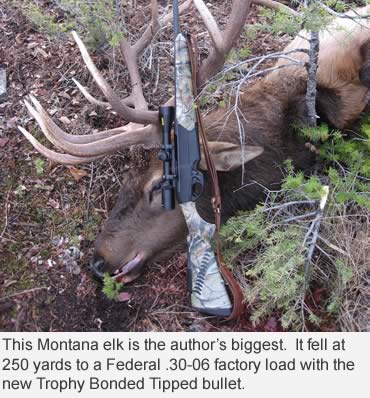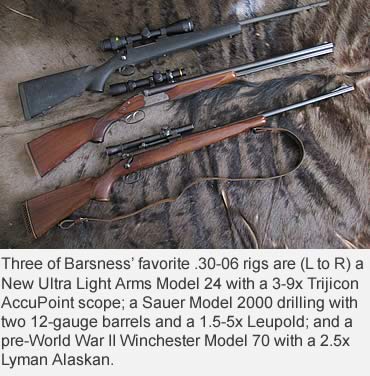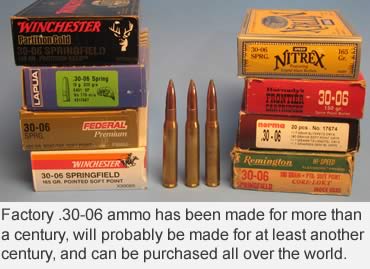Many of us know intellectually that the .30-06 is a good all-around big game cartridge, but explanations are not experience.
The .30-06 was the most common chambering for big game rifles when I started hunting in Montana in the mid-1960s, though some hunters thought it was unnecessarily powerful. My father did, which is the reason I took my first deer with his .30-30 at age 13. Over the next dozen years, I used the .243, .270 and .308 Winchesters before finally ending up with my first .30-06, a Remington 760 pump that a friend needed to sell quickly and, to my good fortune, cheaply.
Many New England whitetail trackers would have considered this ideal, especially with the K3 Weaver scope I mounted. Whitetails were the reason for my 760 as well. Believe it or not, they dominate certain parts of Montana, including the northeastern plains, where brushy draws hold quite a few bucks. Up there, a common hunting method is to jump deer from the coulees and shoot them on the run. By age 24, I was pretty good at this, partly through practice on jackrabbits.
One sunny October day, my wife’s grandfather, Ben, dropped me off at the bottom of a long draw, and then drove his pickup to the top, where he got out and stood, his own .30-06 in his hands. Meanwhile, I’d loaded my pockets with small rocks, and on the way up the draw, tossed them into the thicker brush.
One big buffalo-berry patch required several rocks. After the third rock, a white-tailed buck jumped from the brush and started up the opposite hillside. My first shot missed as the buck suddenly swerved, but I knew how to run a pump gun, and almost immediately my second shot didn’t miss. The buck staggered to the top of the hill, and then fell in the cured autumn grass.
I hiked down into the draw and up the other side while Ben drove down the ridge. “Good shot, kid,” he said as he got out. Later that day, we skinned the buck in Ben’s garage, and I found the expanded bullet under the hide of the right shoulder, a 165-grain Speer Hot-Cor that retained 85 percent of its weight.
From that day onward, a .30-06 was always in my personal mix of rifles. When I started seriously hunting elk in the steep, thickly timbered mountains of northwestern Montana, the rifle I eventually ended up with was a sporterized 1903 Springfield shooting 200-grain Nosler Partition handloads.
 In the winter of 1980, my small collection of sporting rifles was liquidated during a divorce. Early the next autumn, however, I started another collection by purchasing a .30-06, a Ruger 77 on sale at a local store complete with a 4x Bushnell scope. The combination worked well on a wide variety of Montana big game over the next few years, taking not just more whitetails but pronghorn, mule deer, black bear and elk as well.
In the winter of 1980, my small collection of sporting rifles was liquidated during a divorce. Early the next autumn, however, I started another collection by purchasing a .30-06, a Ruger 77 on sale at a local store complete with a 4x Bushnell scope. The combination worked well on a wide variety of Montana big game over the next few years, taking not just more whitetails but pronghorn, mule deer, black bear and elk as well.
Many of us know intellectually that the .30-06 is a good all-around big game cartridge. After all, by the time we reach adolescence, our mentors have explained that fact of life (along with others). But explanations are not the same as experience. When forced by the whims of fate to hunt with one big game rifle, I experienced the .30-06.
Eventually, life’s fortunes turned upward again and more rifles were added to my collection. Nowadays, it’s often difficult to fit another rifle into the house, but I try. I have taken big game with dozens of cartridges ranging in power from the .22-250 Remington to the .416 Rigby.
An entire year may go by without using the .30-06, but then a situation comes up where the choice seems logical. Consequently, I’ve gotten to know the .30-06 even better than when forced to use it exclusively for several years in Montana. I’ve used the .30-06 all over North America, in Africa and Europe, and even on the island nation of New Zealand.
Some other cartridges have gained my admiration. All of the .25s from the .250 Savage to the .257 Weatherby Magnum are favorites for deer-sized game. The 6.5s in chamberings from the .260 Remington to the .264 Winchester Magnum have also gotten a workout. I’ve taken about as much big game with the .270 Winchester as with the .30-06, though not as wide a variety. Throw in a bunch of other cartridges in the .270 class (whether the .270 WSM and .270 Weatherby Magnum, or 7mms from 7mm-08 to 7mm STW), and the list gets very long. Other .30 calibers are frequently used, from the .300 Savage to the .300 Remington Ultra Magnum.
 I also know the .338 Winchester Magnum, .9.3x62 Mauser and .375 H&H quite well and have used all three on a slightly wider variety of big game than the .30-06.
I also know the .338 Winchester Magnum, .9.3x62 Mauser and .375 H&H quite well and have used all three on a slightly wider variety of big game than the .30-06.
These cartridges do provide a healthy thump when hunting bigger game, yet I’ve shot the same variety of game with the .30-06, and it has worked about as well.
Hunters all over the world are convinced that their cartridge, bullet or handload is the answer to the quickest, cleanest kills. Some even devise formulas supposedly indicating how well various cartridges slay big game. Like any true rifle loony, I could quote ballistic statistics that supposedly “prove” quite a few cartridges are better than the .30-06 for specific purposes.
But as my list of cartridges and animals has grown longer, I’ve come to the boring conclusion that shot placement is by far the biggest equation in killing power, with bullet construction an important but distant second. It normally takes at least 10 seconds for a big game animal’s blood pressure to drop after a solid double-lung hit, and no shoulder-fired rifle on earth will change that much. Some animals may fall sooner, especially if the bullet comes close to the spine, but the majority of big game are going to stay upright for a little while after solid chest shots and travel maybe 25 to 50 yards before falling. As a result, I eventually came up with my own formula: 2L = DPQ. This stands for 2 Lungs equals Dead Pretty Quick.
“Average” animals means anything from 100-pound American pronghorn and African springbok to 1,500-pound Alaskan moose and African eland. I have shot non-dangerous game of this size with a pile of different cartridges, and seen just as many animals taken by companions. And if there is a magic formula other than 2L = DPQ, it has eluded me.
A study of close to 8,000 moose killed by Scandinavian hunters came to the same conclusion. Hunters reported the cartridge they used, how many shots landed and how far each moose traveled until it fell. The average was around 1.5 hits, and the distance the moose traveled averaged about 40 yards after the first shot, regardless of whether the cartridge was a 6.5x55 or a .375 H&H.
I have personally shot a 75-pound springbok with a 260-grain .375 H&H bullet, putting a hole the size of a football through both lungs. The springbok ran more than 50 yards before stopping, weaving and falling. That’s one example never valid in statistics, though it’s the sort of example most hunters use to “prove” a point about their favorite. I’ve seen that same sort of thing hundreds of times on all sorts of animals. Sometimes they drop instantly to a solid heart-lung shot, but more often, it takes a little time.
 American hunters like to argue about the perfect cartridge for various animals. There are two reasons for this: Americans citizens still have the easiest access to firearms in the world, so we can try everything; and we normally only hunt one species at a time. We’re going deer hunting, or pronghorn hunting, or black bear hunting, or elk hunting, so we argue endlessly over the practically perfect deer, pronghorn, black bear or elk cartridge.
American hunters like to argue about the perfect cartridge for various animals. There are two reasons for this: Americans citizens still have the easiest access to firearms in the world, so we can try everything; and we normally only hunt one species at a time. We’re going deer hunting, or pronghorn hunting, or black bear hunting, or elk hunting, so we argue endlessly over the practically perfect deer, pronghorn, black bear or elk cartridge.
In Montana, I often hunted two or even three of these animals at the same time, so got past the perfect cartridge notion pretty early. I’ve also hunted diverse species in other places, from Alaska and, especially, Africa, where the hunter never knows what animal might show up next.
So what cartridge do we use when hunting different animals, whether mule deer and elk, black bear and moose, or springbok and kudu? I would hunt any of the above with any cartridge from a 7x57 to a .375 — and pretty much have. But believe me, there isn’t anything that beats the .30-06 by a wide margin, and there are advantages in not constantly flitting from one perfect cartridge to another. The first is familiarity. If we know one cartridge and its trajectory, then we’re far more likely to put the bullet in the right place. Today, laser rangefinders and multi-point scope reticles make accurate shooting out to 400-plus yards pretty easy, even if we don’t use a flat-shooting magnum.
Supposedly, the .30-06 is very versatile because of its bullet selection. When my primary job was delivering newspapers via bicycle, the gun writers of the world suggested 150-grain spitzers for deer, 180s for elk and roundnose 220-grain bullets for really big animals like moose and brown bears. This made sense back then, before new, improved super-bullets started appearing even more rapidly than new, improved cell phones.
By the time I started using the .30-06, however, two bullet weights seemed more sensible: 165 and 200. These were touted as compromises between the old-time triad, and they worked. In my Ruger 77, I used a standard 165-grain spitzer for deer-sized game, and a 200-grain Nosler Partition for bigger stuff. Both loads shot to the same place, so the system worked quite easily.
After gaining more experience, however, I found that the stodgy old 180-grain works fine on everything. It shoots flat enough to ranges much farther than most of us should be shooting, and drifts noticeably less in the wind than the traditional open-country 150-grain load.
Since that revelation, I have used 180s of various sorts to take a long list of big game, including one of my biggest mule deer (360 yards), my biggest caribou (430 yards), my biggest elk (250 yards), and the longest shot I’ve made on any trophy animal in Africa, a kudu standing close to 400 yards up a mountain. In fact, the 180-grain .30-06 works so well that I’ve also used it to take a number of deer and pronghorns because it doesn’t tear up as much meat as the 150 grain.
Additionally, the traditional 2,700 fps muzzle velocity of the 180 allows a standard bullet to hold together darn well, even on fairly large game. And if somehow you and your special ammunition get separated, .30-06 ammo can be purchased anywhere ammunition is available. I’ve had this happen, even in Montana, when a companion drove off with my ammo halfway through a hunt because of some emergency at home. I went to the nearest store and bought a box of factory .30-06 ammunition.
You can do the same thing at a gas station in Jordan, Mont., perhaps the most isolated county seat in the lower 48, or my friend Rob Klemp’s sporting goods store in Kimberley, South Africa.
Half a dozen of my big game rifles are chambered for the .30-06. These include a New Ultra Light Arms Model 24 (6 1/2 pounds with scope), a couple of pre-’64 Model 70 Winchesters, a custom 1903 Springfield, a Ruger No. 1A single shot and a Sauer drilling with a pair of 12-gauge barrels over the rifle barrel. These days, I’m usually more interested in the big game rifle itself than which cartridge it should be chambered for because the last part is easy.
This article was published in the October 2009 edition of Buckmasters GunHunter Magazine. Subscribe today to have GunHunter delivered to your home.